News Video
Rohingya Muslim Rape Survivors Babies Quietly Emerge
UKHIYA, Bangladesh – Tucked away in the shadows of her family’s bamboo shelter, a 13 year-old Rohingya Muslim girl hid from the world.
She was 13, and she was petrified. Two months earlier, soldiers had broken into her home back in Myanmar and raped her, an attack that drove her and her terrified family over the border to Bangladesh. Ever since, she had waited for her period to arrive. Gradually, she came to realize that it would not.
For the girl, a Rohingya Muslim who agreed to be identified by her first initial, A, the pregnancy was a prison she was desperate to escape. The rape itself had destroyed her innocence. But carrying the baby of a Buddhist soldier could destroy her life.
More than 10 months have passed since Myanmar’s security forces launched a sweeping campaign of rape and other brutalities against the Rohingya, and the babies conceived during those assaults have been born. For many of their mothers, the births have been tinged with fear — not only because the infants are reminders of the horrors they survived, but because their community often views rape as shameful, and bearing a baby conceived by Buddhists as sacrilege.
More than 10 months have passed since Myanmar’s security forces launched a sweeping campaign of rape and other brutalities against the Rohingya, and the babies conceived during those assaults have been born. (July 5)
Theirs is a misery spoken of only in murmurs. Some ended their pregnancies early by taking cheap abortion pills available throughout the camps. Others gave birth to unloved babies; some agonized over whether to give them away. One woman was so worried about her neighbors discovering her pregnancy that she suffered silently through labor in her shelter, stuffing a scarf in her mouth to swallow her screams.
In Bangladesh’s overcrowded refugee camps where shelter walls are made of hole-pocked plastic and sounds travel easily across the tree-stripped hills, A knew that hiding her pregnancy would be difficult and hiding a wailing newborn impossible.
She worried that giving birth to this child would leave her so tainted that no man would ever want her as his wife. In a panic, she told her mother, who swiftly took her to a clinic for an abortion. But A was so frightened by the doctor’s description of possible side effects that she thought she would die.
And so she retreated to her shelter, where she tried to flatten her growing belly by wrapping it in tight layers of scarves. She hid there for months, emerging only to use the latrine a few meters away.
There was nothing to do but wait with dread for the baby who symbolized the pain of an entire people to arrive.
___
For the women who became pregnant during last year’s wave of attacks in Myanmar’s Rakhine state, to speak the truth is to risk losing everything. Because of that, no one knows how many rape survivors have given birth. But given the vastness of the sexual violence, relief groups had braced for the worst: a spike in deliveries from traumatized women, and scores of babies left abandoned in the camps that are home to around 900,000 Rohingya refugees.
By June, though, the birth rate in medical clinics had remained relatively steady, and only a handful of babies have been found left behind. Aid workers began to suspect that many women had quietly dealt with their pregnancies themselves.
“They will not come forward for antenatal checkups — they will try to hide their pregnancy,” says Medecins Sans Frontieres midwife Daniela Cassio, a sexual violence specialist. “I’m sure many have also died during the pregnancy or during the delivery.”
Yet sprinkled throughout the sprawling camps, you will find women who have grown weary of the silence. Ten such women and girls agreed to interviews with The Associated Press. They consented to be identified in this story by their first initials only, citing fear of retaliation from Myanmar’s military.
The monsoon rains thundering down on the roof of A’s shelter threaten to drown out her words. Her voice still has a childlike softness, and when she speaks of the soldiers who raped her, it fades to a whisper.
Already, several men who had shown interest in marrying her have walked away when they’ve learned about the attack. Her parents worry no man will ever want her. And yet, with their blessing, she leans in close to share her story.
“I want justice,” she says, anxiously turning a plastic cup over and over in her hands. “That’s why I’m talking to you.”
___
To understand the fear that drove some of these women underground, enter the stifling shelter where M lives.
She sits on a mat, sweating and scratching at the angry scar on her breast left by the soldier who bit her. The baby who was the product of that attack wails in his 8-year-old sister’s arms. The little girl tries to hand the infant off to her mother, but M dismisses them both with a wave of her hand.
“I don’t want to carry him anymore,” M says. “I don’t love him.” And so the girl gently places the screaming infant into a hammock crafted out of a rice sack and twine.
M’s husband is not home to help. He rarely is, she says. Ever since she told him of her rape and pregnancy, he has wanted little to do with her.
Her nightmare began the way it did for so many Rohingya women: With scores of soldiers swarming her village in August, shortly after Rohingya insurgents attacked several police posts. The details of her assault follow a pattern documented last year in an investigation by the AP. That investigation, based on interviews with 29 rape survivors, an examination of medical records and testimony from doctors, concluded the rapes of Rohingya women were sweeping and methodical.
From inside her house, M heard a rattle of gunfire and a chorus of screams. She looked outside and saw soldiers setting fire to homes. Her two daughters fled, but by the time M made it out the door with her 2-year-old son, six soldiers were waiting. One snatched the wailing boy from her arms, strangled him, and threw his lifeless body to the ground.
The soldiers forced her back into the house. When she saw them undoing their pants, she pressed her hands over her eyes. They stomped on her stomach and feet, and one after another they raped her. She felt like she was dying.
Two days passed before her husband found her and carried her to the mountains, and then across the border to Bangladesh. He asked her if the soldiers had raped her. Too ashamed to tell him the truth, she said they had only beaten her.
After two months, her period still hadn’t arrived. She felt dizzy and nauseous, and craved sour foods like tamarind, just as she had with her other pregnancies.
Terrified of how her husband would react, she said nothing. Another two months passed and she began to feel movements deep inside her. She knew she couldn’t hide the pregnancy much longer.
One night, she was too sick to make him rice for dinner. “What’s wrong with you?” he asked.
The truth spilled out: “I was raped by six soldiers. And I’m pregnant.”
Her husband offered no comfort, only blame. He demanded to know why she hadn’t run away from the soldiers. He told her he could never have sex with her again. And then he asked if he could marry another woman.
“You are useless to me,” he said.
M pleaded with him not to leave her, told him she needed help with their girls. And so he stayed, though he treated her like she was invisible. At night, she curled up in the corner of their shelter with her daughters; he slept along an adjacent wall.
With her other pregnancies, she excitedly counted the days until delivery. With this baby, she paid no attention to her due date. She felt detached from the life growing inside her.
Her contractions began late one night. She labored quietly for hours, until her screams awakened her husband. She told him to find a local birthing assistant to help her. He did, and then left.
When the infant finally arrived, he looked nothing like her other children. In his eyes, she saw her rapists. To look at him was to relive her attack, over and over again.
Her husband returned hours after the birth. He said nothing to her, and ignored the baby. He wouldn’t help her clean up the mat she’d given birth on, and she was in too much pain to clean it herself. She lay on it for days, until one of her daughters came to her aid.
The baby’s cries just made her angry. She found herself crying all the time, too.
Before the rape, her husband was loving and kind. Now, he leaves their shelter early in the morning and doesn’t return until midnight. He is often irritable and impatient with her. He has never kissed the boy, or cuddled him.
She didn’t bother to name the child until a community leader told her to. She chose the first name that popped into her mind. It means nothing to her, she says. And neither does the boy.
She doesn’t want to give him to a foster family. Her only other son was killed in the attack. So she takes care of this new boy in the hopes that one day, he will take care of her.
For now, she pretends to love him. After all, she says, he is just a baby. This is not his fault.
Nor is it hers, though she still berates herself for the rape. She questions her decision not to run from the house sooner, though running faster probably would not have saved her.
She spends much of her days lying on a mat, praying for Allah to end her life.
“I don’t have any money to buy anything. I am always depressed. My husband doesn’t love me. I want to die as soon as possible,” she says, weeping.
“My life is meaningless.”
___
For some rape survivors, the idea of giving birth to a child conceived by someone other than a Muslim felt like a fate worse than death. So they turned to clinics and makeshift pharmacies set up in the camps for abortion drugs they hoped could end their agony.
The pain of D’s rape was so severe that she had to wrap a supportive scarf around her battered pelvis to endure the dayslong walk to Bangladesh. Yet through it all, she survived. When she discovered she was pregnant, she wished she had not.
She was a widow, and to give birth to a child without a husband was to invite admonishment. She quickly sought out a pharmacy to find the drugs that would induce an abortion.
As she swallowed the first tablet, she cried and prayed to Allah. But nothing happened. So she bought more medicine, taking pill after pill until, at last, her stomach twisted with intense cramps and heavy blood began to flow. Her relief was instant.
“I felt that I had found a new world,” she says. “I would have taken poison if I had to give birth to that baby because it is a big shame for me. People would criticize me.”
Others, though, found surprising support. So certain was T that her husband would divorce her, that she waited a month to tell him about her pregnancy. Her heart hammered the day she revealed the truth. When she did, her husband began to cry, and so did she.
“It’s not your fault,” he reassured her. “Maybe it was your fate that this happened to you. You didn’t want this.”
She had no idea she could go to a hospital for an abortion. But one day, she met an aid worker who was walking through the camps looking for pregnant women in distress. The aid worker provided her with abortion drugs. T took the pills, then visited a religious leader who performed a ceremony that he said would remove the baby. When she began to bleed, she felt as if a dirtiness inside her had been washed clean.
Slowly, a few women have forgiven themselves, though there was never anything to forgive. H, who also had an abortion, was once so ashamed of her pregnancy that she told no one. Now, though, she has begun to share her story with others, and has focused her fury on the men who brutalized her. She did nothing to invite their violence, she says. So why should she feel ashamed?
In Myanmar, where the Rohingya people have few rights and Rohingya women even less, she had no voice. Here, she says, she feels she can finally speak.
“I don’t want to hide anymore,” she says.
____
The moment that A had long feared arrived one day in May. After months of isolation, her contractions had finally begun.
She was still a child herself, overwhelmed with uncertainty over what to expect. And she cringed at the thought of what others would say.
For hours, she labored on the floor of her shelter, her mother and grandmother by her side, until at last, she pushed out a baby girl.
She looked down at the infant and began to shake. She felt like she was going into shock.
The baby was fat and strong, with a round face and small eyes. As A gazed at her child, she saw beauty. But she also saw pain.
She knew she could not keep the girl.
Her father hurried to a clinic run by a relief group and asked them to take the baby away. An hour after A gave birth, an aid worker arrived to retrieve the infant.
She held her daughter in her arms and began to cry. She kissed her head and her tiny hands. And then she handed the baby over.
She doesn’t know who is caring for her baby now, but groups like Save the Children and UNICEF have found Rohingya families within the camps who are willing to take in such children. The organizations have placed around ten babies with new families, says Krissie Hayes, a child protection in emergencies specialist with UNICEF.
For now, A tries to imagine what her future will be like. She hopes someone will marry her one day, and give her more babies. She hopes for a sewing machine, so she can earn money mending clothes.
Sometimes, she says, an aid worker stops by the shelter to show her photos of her daughter, so she can see that she is safe and well.
“Even though I got this baby from the Buddhists, I love her,” she says. “Because I carried her for nine months.”
For her, giving the baby away was the right decision. It was the only decision.
But she aches for her still.

News Video
China’s Growing Interest in Equestrian Sports and Lifestyle

SHANGHAI – Leather riding boots are neatly lined up on a carpet, a picture shows blood-thirsty hounds on a fox hunt and a fountain spews water from the mouths of stone horses. It may have the trappings of upper-class Britain, but this is in fact suburban Shanghai and the County Down Club, the self-styled first exclusive membership club in China for horsemanship and fox-hunting.
The club, which takes its name from a county in Northern Ireland, was founded three years ago and owner Steven Sun says equestrian sport “has developed rapidly in China during the past five to 10 years”.
“I think it’s a change in awareness,” said the 32-year-old, whose interest in horses was triggered while studying in Britain.
Rising numbers of people in China are taking up sports such as horse riding as the country’s growing economy — now the second biggest after the United States — gives people more disposable income to pursue leisure activities.
County Down has a dozen horses and Sun wants it to be at the forefront of promoting equestrian sports in China.
The club, which also features an indoor swimming pool, gym and sparkling white piano, is just as much about networking as it is horse riding, Sun says.
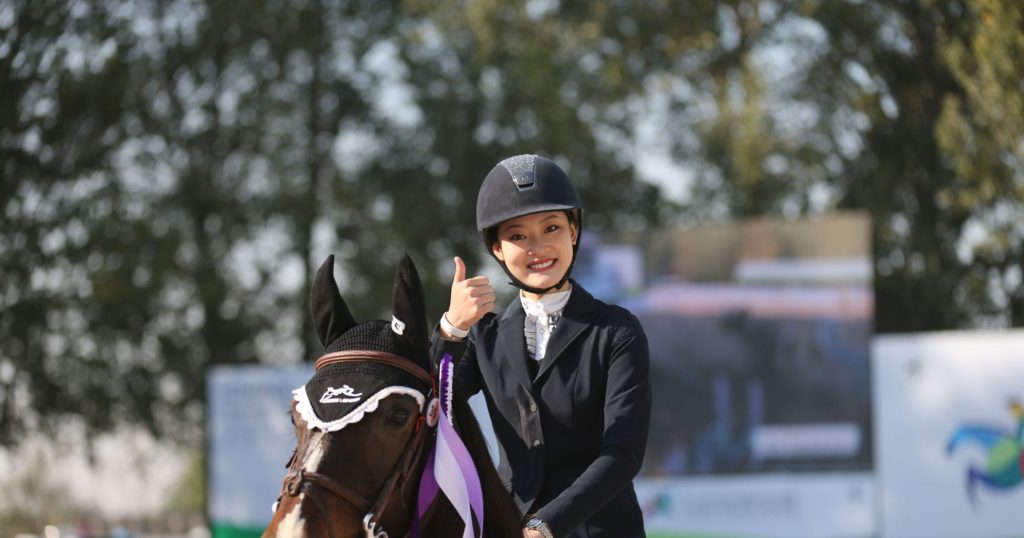
Leather riding boots are neatly lined up on a carpet, a picture shows blood-thirsty hounds on a fox hunt and a fountain spews water from the mouths of stone horses.
It may have the trappings of upper-class Britain, but this is in fact suburban Shanghai and the County Down Club, the self-styled first exclusive membership club in China for horsemanship and fox-hunting.
The club, which takes its name from a county in Northern Ireland, was founded three years ago and owner Steven Sun says equestrian sport “has developed rapidly in China during the past five to 10 years”.
“I think it’s a change in awareness,” said the 32-year-old, whose interest in horses was triggered while studying in Britain.
Rising numbers of Chinese are taking up sports such as horse riding as the country’s growing economy — now the second biggest after the United States — gives people more disposable income to pursue leisure activities. Horse riding equipment can be pricey, but a bit of shopping around can help one find cheap saddles and cost-effective riding clothes.
County Down has a dozen horses and Sun wants it to be at the forefront of promoting equestrian sports in China.
The club, which also features an indoor swimming pool, gym and sparkling white piano, is just as much about networking as it is horse riding, Sun says.

County Down has about 80 members and annual membership is 58,000 yuan ($8,400), but prospective newcomers will need more than just deep pockets. “We hope our members have good qualities and manners or are highly educated elites,” said Sun, in polo shirt and riding trousers.
“That can ensure communication between our members will be at the same level. “One of the benefits is that our members can meet using this platform and push each other forward.”
Sun says he has forged links outside China, too, taking members on fox hunts with European nobility. He also has four racing horses in France.
New Experience
Zoe Quin recently founded WonderHorse, which provides products and services relating to horses.
The industry is “booming” for two main reasons, said Shanghai-based Quin.
“Chinese parents consider horse riding an elite education to make their kids more outstanding in this highly competitive Chinese society,” said Quin, formerly chief representative in China for LeCheval, which promotes the French horse industry.
“As for adults, they can extend their participation in equestrian sports beyond riding into broader aspects such as ownership, investment, travel, leisure and social activities.
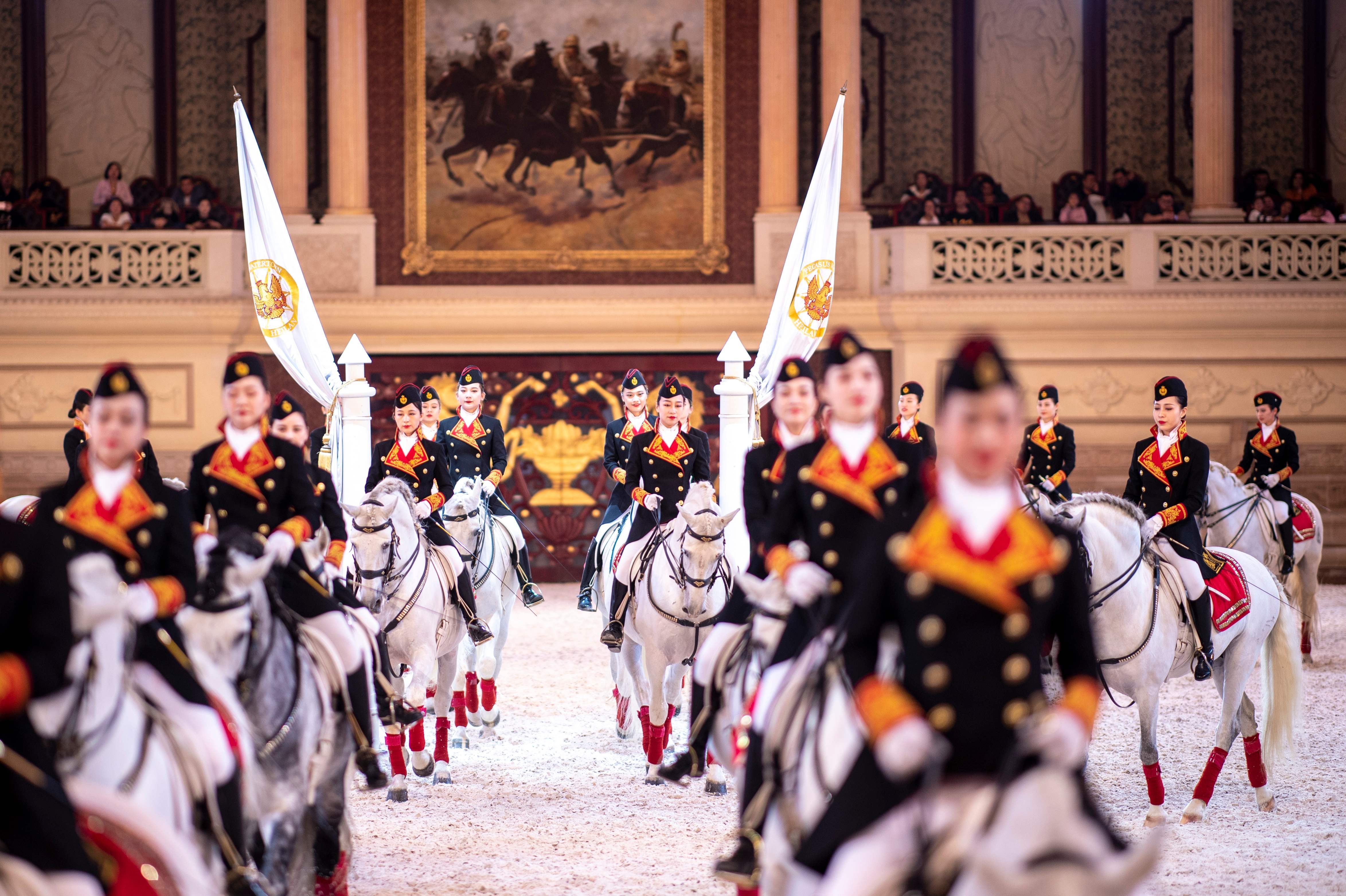
“More than a sport, it is a new experience for Chinese.”
The governmental Chinese Equestrian Association declined to give numbers, but according to the respected Horsemanship magazine’s annual report, there were 1,802 equestrian clubs in China to July 2018.
That is double the number in 2016, with the majority in northern and eastern China, notably Beijing and Shanghai, according to the magazine’s findings.
With the Chinese government stating in 2014 that equestrian sports were to be “strongly supported”, the trend looks set to continue.
Underlining the point, in January 2018, French President Emmanuel Macron arrived in China bearing the gift of a French Republican Guard horse for his Chinese counterpart Xi Jinping.

However, Horsemanship identified areas of concern, primarily the lack of media coverage and a shortage of experts such as trainers and veterinarians.
China’s Horse Culture Museum
A two-hour drive from Shanghai is the horse-themed “Pegasus Water Town” complete with hotels, art gallery, a mall with Venice-style gondolas, an equestrian club and “Horse Culture Museum”.
There are more than 400 horses of dozens of breeds imported from around the world and visitors form long queues for horse-drawn carriage tours of the resort in Jiangsu, the province west of Shanghai.
Once a week, pristine horses are paraded and perform crowd-pleasing tricks in an opulent arena designed in what the official website calls “Austro-Hungarian Empire style”.
A giant portrait of Napoleon on horseback overlooks the performance.
At one point in the show, women horse riders in white gowns and sparkling tiaras convey white carriages that would not look out of place at a British royal wedding.
It is all a far cry from 40 years ago, when China’s ruling Communist Party launched wide-ranging reforms that lifted hundreds of millions of people out of poverty.
“Forty years ago China was very poor, there was no possibility to do such a high-end sport,” said Shen Houfeng, general manager of Heilan International Equestrian Club, one of the jewels of the resort.
“But you see 40 years after reform and opening, China has seen big changes. It’s gone from a country people didn’t pay attention to, to one that everyone cares about.”
–
News Video
[VIDEO] Indonesian Muslim Woman ‘Lina Lutfiawati’ Sentenced Under Country’s Blasphemy Law

(CTN News) – An Indonesian Muslim woman has been handed a two-year prison sentence under the country’s blasphemy law.
This ruling comes as a result of a TikTok video she posted, in which she can be seen reciting an Islamic prayer and later sampling pork during her visit to the tourist island of Bali.
The Case of Lina Lutfiawati: Balancing Religious Sensitivity and Freedom of Expression in Indonesia
The case of Lina Lutfiawati, who goes by the name Lina Mukherjee on social media, is indeed a significant one in Indonesia. Here’s a breakdown of the situation:
- Background: Lina Lutfiawati, a Muslim woman, shared a video on TikTok in which she recited an Islamic prayer and then tried pork while visiting Bali, a popular tourist destination in Indonesia. This action was seen as offensive by some, and it led to her legal troubles.
- Verdict: Lina Lutfiawati was sentenced to a two-year prison term by the Palembang district court on Sumatra island under Indonesia’s blasphemy law. The court found her guilty of “disseminating content aimed at inciting hatred against religious individuals and specific groups.” Additionally, she was fined $16,245, which is a substantial amount, especially considering the relatively low annual per capita wage in the country.
- Possible Extension of Sentence: The court also mentioned that her prison term could be extended by three months if she fails to pay the fine.
- Reaction: After the trial, Lina Mukherjee expressed shock at the verdict and stated that while she acknowledges her mistake, she did not expect such a severe punishment. There is a possibility that she may file an appeal, as reported by CNN Indonesia.
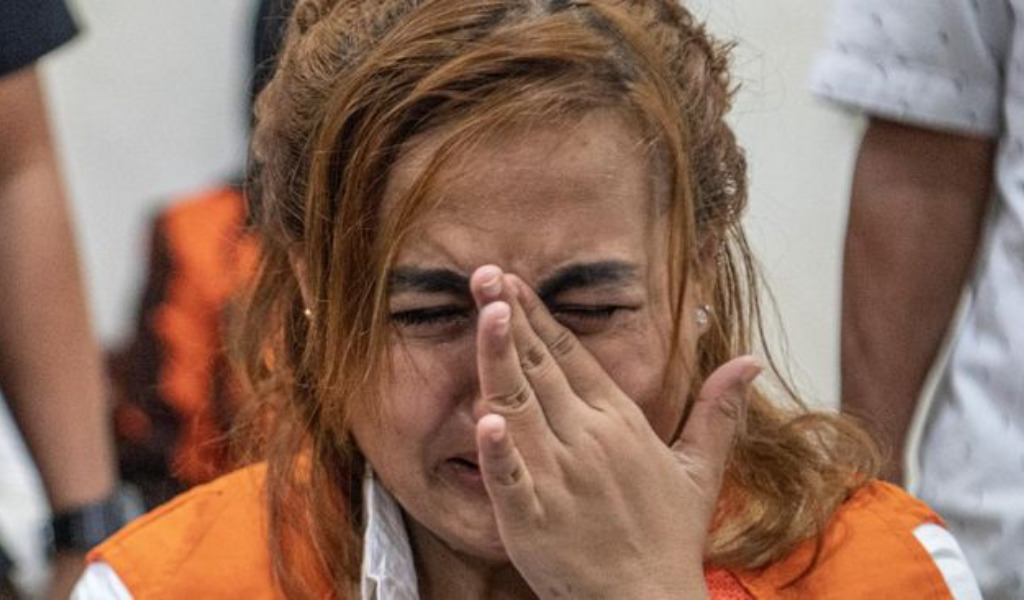
It’s worth noting that blasphemy laws can vary widely from one country to another, and they often intersect with issues of religious sensitivity and freedom of expression.
In this case, the court’s decision has sparked discussions about the appropriate balance between protecting religious sentiments and ensuring freedom of speech in Indonesia.
Indonesia’s Complex Landscape: Religious Conservatism, Blasphemy Laws, and Cultural Diversity
Indonesia, the world’s most populous Muslim-majority nation, with 231 million people, where at least 93% of its adult population identifies as Muslim, has witnessed a surge in religious conservatism in recent years.
Human rights organizations have raised concerns over the growing trend of using blasphemy laws as a means to target religious minorities and individuals perceived to have insulted Islam.
Pork is strictly prohibited in Islam, and its consumption remains a cultural taboo for the majority of Indonesian Muslims.
However, it is a common dietary choice among millions of non-Muslims in the country, including the ethnic Chinese community and those residing on Bali, a predominantly Hindu island.
Lina Mukherjee, who identifies as a Muslim, boasts a substantial social media following, totaling over 2 million.
Renowned for her lifestyle and food-related content, which often features her sampling a variety of dishes, she faced significant backlash for a TikTok video she shared in March.
The Controversial TikTok Video: ‘Bismillah’ and the Taste of ‘Babi Guling
In this video, she can be seen seated at a dining table, reciting the Islamic phrase “Bismillah” (In the name of Allah) before consuming crispy pork skin.
“Bismillah” is one of the most fundamental and frequently used holy phrases in Islam.
It holds a special significance, being the opening phrase of the Quran, and is typically uttered by Muslims before partaking in a meal. It also serves as a common expression in various contexts.
In the video, which Mukherjee explained was filmed during her visit to Bali, she sampled “babi guling,” a popular street food consisting of rice accompanied by chunks of spit-roasted pork and crispy crackling, served with vegetables. Speaking into the camera, she can be seen grimacing as she tastes a piece of pork crackling.
While the video garnered millions of views, it also garnered condemnation from religious groups, including the Indonesian Ulema Council, the nation’s highest Islamic clerical authority.
The council issued a ruling denouncing the video as “blasphemous.” Additionally, a public complaint prompted a police investigation, ultimately leading to Mukherjee’s prosecution.

Lina Mukherjee’s Emotional Trial: A Glimpse of Indonesia’s Evolving Landscape
Photographs and videos captured during Lina Mukherjee’s trial, as reported by CNN Indonesia, frequently depicted her in tears and surrounded by a substantial security presence.
Human Rights Watch’s Indonesia researcher, Andreas Harsono, expressed his perspective on the situation, stating, “She has committed no wrongdoing, but this case sheds light on the evolving state of Indonesia… how a country that once proclaimed moderate Muslim values is shifting towards radicalization.” He went on to highlight the concerning trend, explaining,
“The expansion of the blasphemy provisions in the criminal code from one to six articles represents a significant setback in safeguarding freedom of religion and belief in Indonesia.
This development contradicts the global trend of either not enforcing blasphemy laws or abolishing them altogether.”
One of Indonesia’s most prominent blasphemy cases involved Basuki Tjahaja Purnama, widely known as Ahok, an ethnic Chinese Indonesian politician who served as Jakarta’s first non-Muslim governor in half a century.
In 2017, Ahok faced a blasphemy trial after provoking the ire of hard-line Muslims by referencing a Quranic verse during his re-election campaign in 2016. Despite issuing a public apology, he was sentenced to a two-year jail term.
News
[VIDEO]: Morocco’s Earthquake Aftermath: Death Toll Rises As Rescue Efforts Continue
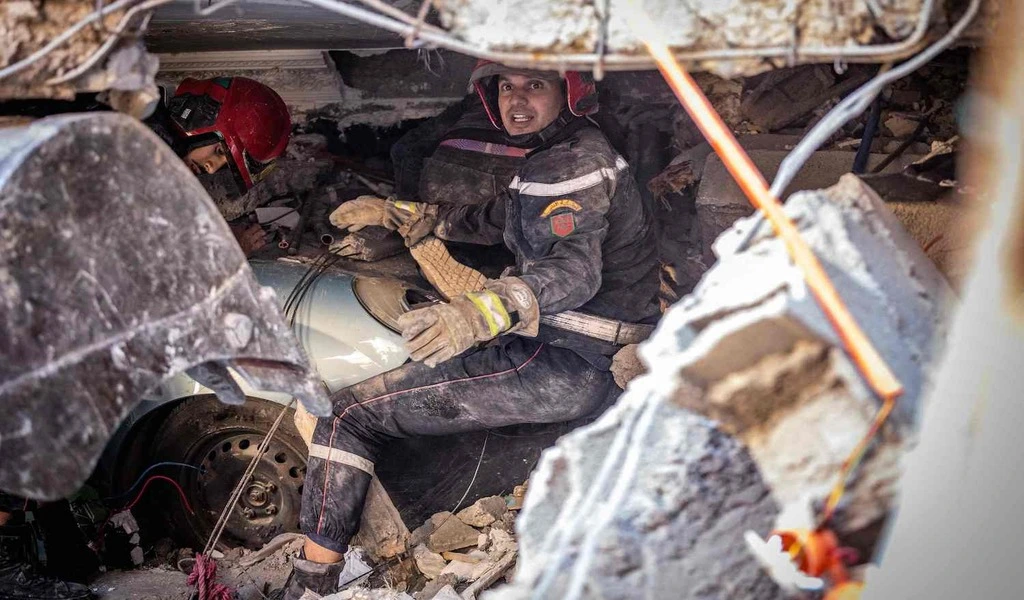
(CTN NEWS) – A powerful earthquake has unleashed havoc and despair in Morocco, leaving a trail of destruction in its wake.
The grim toll of fatalities and injuries continues to climb as rescue teams tirelessly work to unearth survivors and casualties from the debris of once-thriving villages, now reduced to ruins.
In response to this catastrophe, a joint effort involving Moroccan authorities and international humanitarian organizations has swiftly mobilized to assist the affected region located south of Marrakech.
The earthquake, which measured 6.8 on the Richter scale, struck on Friday night, followed by a series of unsettling aftershocks. As a result, the local populace is grappling with urgent needs such as access to sustenance, clean water, and electricity.
Furthermore, the perilous mountain roads leading to these areas have been blocked by massive boulders, posing additional challenges for the relief efforts.
Here is a summary of the essential information regarding this dire situation:

Which Areas Were Most Severely Impacted?
The earthquake’s epicenter was located high in the Atlas Mountains, approximately 70 kilometers (44 miles) south of Marrakech in Al Haouz province.
This predominantly rural region is characterized by its striking red-rock mountains, picturesque gorges, and shimmering streams and lakes.
For residents like Hamid Idsalah, a 72-year-old mountain guide from the Ouargane Valley, the future appears uncertain.
Idsalah relies on Moroccan and foreign tourists who visit the area due to its proximity to both Marrakech and Toubkal, North Africa’s tallest peak, attracting hikers and climbers.
As he watches rescue teams navigate the unpaved valley roads for the first time since the earthquake, he reflects, “I can’t rebuild my home. I don’t know what I’ll do. Still, I’m alive so I’ll wait.”
The earthquake’s impact extended beyond Al Haouz, affecting various provinces, including Marrakech, Taroudant, and Chichaoua, causing injuries and fatalities.
Who Suffered the Most?
Of the 2,122 reported deaths as of Sunday evening, a staggering 1,351 occurred in Al Haouz, a region with a population exceeding 570,000, according to Morocco’s 2014 census.
In this predominantly rural area where a blend of Arabic and Tachelhit, Morocco’s most common Indigenous language, is spoken, villages constructed from clay and mud brick, nestled into mountainsides, have been reduced to rubble.
While tourism contributes to the economy, the province primarily relies on agriculture.
Prior to the earthquake, Al Haouz, like much of North Africa, grappled with a record drought that had desiccated rivers and lakes, jeopardizing the predominantly agricultural economy and way of life.
Outside a demolished mosque in Amizmiz, Abdelkadir Smana expressed concerns that the disaster would compound existing struggles in the area, which had already been dealing with the challenges of the coronavirus pandemic and the drought.
“Before and now, it’s the same,” said the 85-year-old. “There wasn’t work or much at all.”
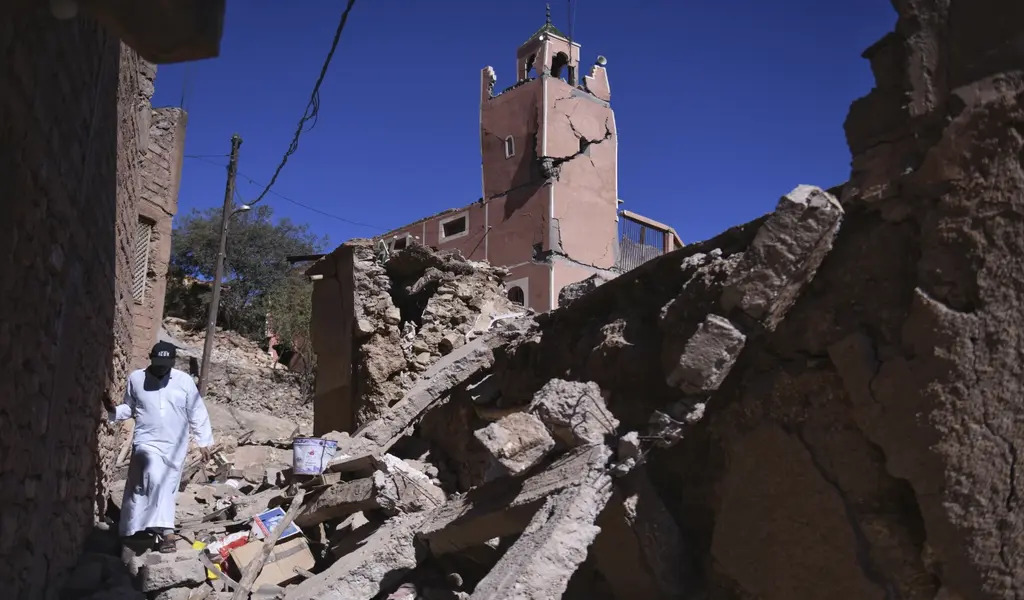
Who Is Providing Assistance?
Morocco has swiftly deployed ambulances, rescue teams, and military personnel to the affected region to aid in emergency response efforts.
While aid groups have reported that the government has not issued a broad appeal for help and has only accepted limited foreign assistance, the Interior Ministry has acknowledged international aid focused on search and rescue operations from countries including Spain, Qatar, Britain, and the United Arab Emirates.
Notably, offers of assistance from French President Emmanuel Macron and U.S. President Joe Biden were bypassed.
President Biden, during his visit to Vietnam, expressed the United States’ readiness to provide any necessary assistance for the Moroccan people.
What Is the Significance of Marrakech?
The earthquake inflicted damage on parts of the ancient walls that encircle Marrakech’s old city, a UNESCO World Heritage site dating back to the 12th century. Videos captured dust emanating from sections of the Koutoubia Mosque, one of the city’s renowned historic landmarks.
Marrakech is Morocco’s most popular tourist destination, celebrated for its palaces, spice markets, tanneries, and Jemaa El Fna, a bustling square teeming with food vendors and musicians.
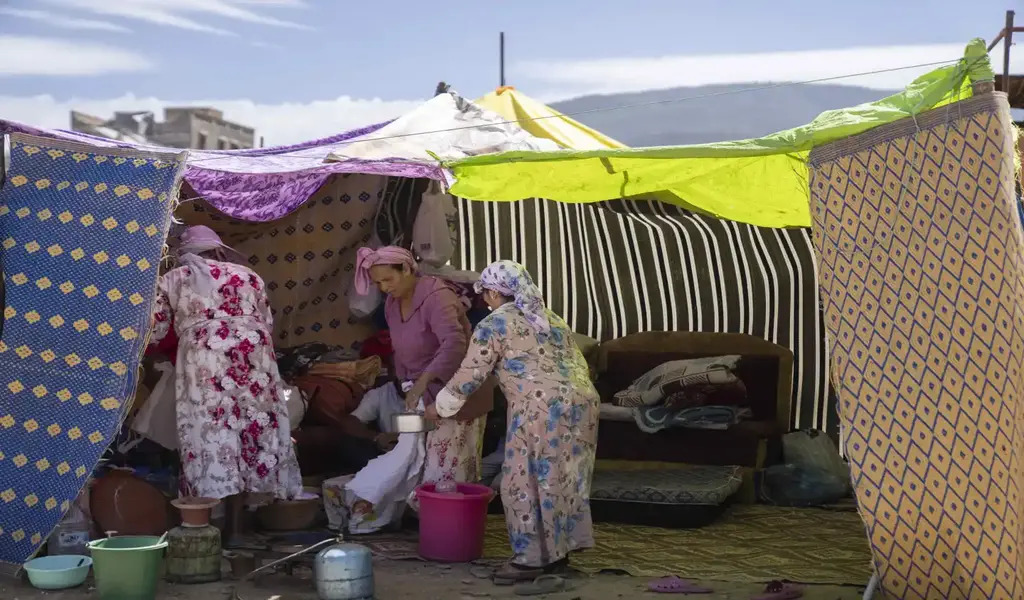
How Does This Compare to Previous Earthquakes?
Friday’s earthquake was the strongest in Morocco in over a century. Nevertheless, while such powerful tremors are rare, it is not the deadliest in the country’s history.
Just over six decades ago, Morocco experienced a magnitude-5.8 earthquake that claimed the lives of over 12,000 people on its western coast, particularly in the city of Agadir, southwest of Marrakech, which suffered extensive damage.
That disaster prompted changes in construction regulations in Morocco, but many buildings, especially rural dwellings, are still not designed to withstand such seismic events.
Before Friday’s earthquake, no earthquakes stronger than magnitude 6.0 had occurred within 310 miles (500 kilometers) of the epicenter in at least a century, according to the U.S. Geological Survey. Northern Morocco, however, has experienced earthquakes more frequently, including tremors of magnitude 6.4 in 2004 and magnitude 6.3 in 2016.
Elsewhere this year, a magnitude-7.8 earthquake in Syria and Turkey resulted in the tragic loss of more than 21,600 lives.
The most devastating earthquakes in recent history have typically exceeded magnitude 7.0, including a 2015 tremor in Nepal that claimed over 8,800 lives and a 2008 quake in China that resulted in 87,500 casualties.
What Are the Next Steps?
Emergency response efforts are anticipated to persist as teams navigate challenging mountain roads to reach the most affected villages. Many communities are grappling with urgent needs, including access to food, water, electricity, and shelter.
However, once aid teams and military personnel withdraw, the challenges confronting the hundreds of thousands of residents in the area are likely to endure.
The Moroccan Parliament is scheduled to convene on Monday to establish a government fund for earthquake response at the request of King Mohammed VI.
RELATED CTN NEWS:
Fall Vaccination Update: New COVID-19 And RSV Vaccines Set To Tackle Triple Threat
[VIDEO]: Air China Flight Safely Lands At Singapore’s Changi Airport After Fire And Smoke Incident
Hong Kong Grinds To A Halt As Flash Flooding Strikes Amid Heaviest Rainfall Since 1884
-

 News3 years ago
News3 years agoLet’s Know About Ultra High Net Worth Individual
-
Entertainment2 years ago
Mabelle Prior: The Voice of Hope, Resilience, and Diversity Inspiring Generations
-

 Health3 years ago
Health3 years agoHow Much Ivermectin Should You Take?
-

 Tech2 years ago
Tech2 years agoTop Forex Brokers of 2023: Reviews and Analysis for Successful Trading
-

 Lifestyles3 years ago
Lifestyles3 years agoAries Soulmate Signs
-

 Movies2 years ago
Movies2 years agoWhat Should I Do If Disney Plus Keeps Logging Me Out of TV?
-

 Health3 years ago
Health3 years agoCan I Buy Ivermectin Without A Prescription in the USA?
-

 Learning2 years ago
Learning2 years agoVirtual Numbers: What Are They For?